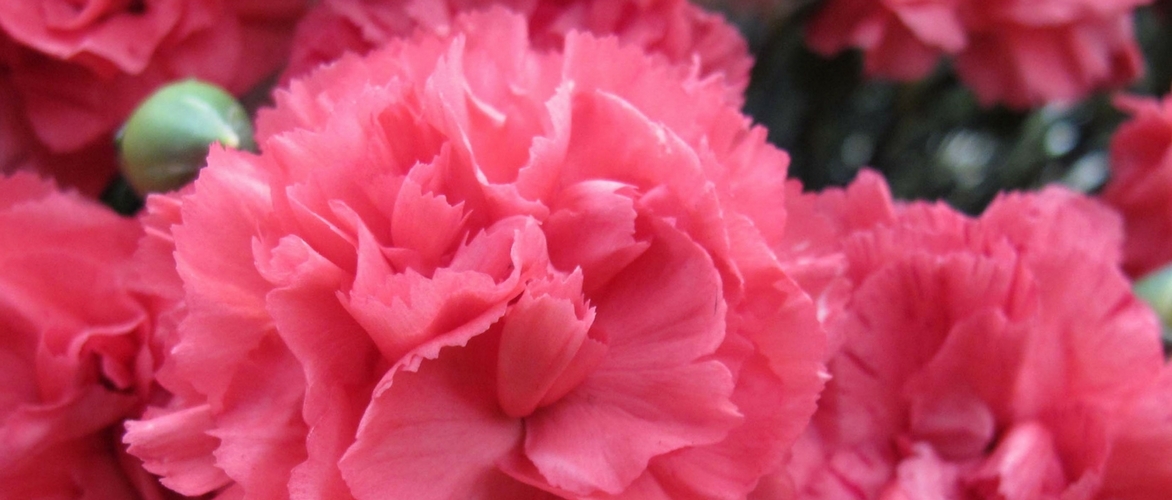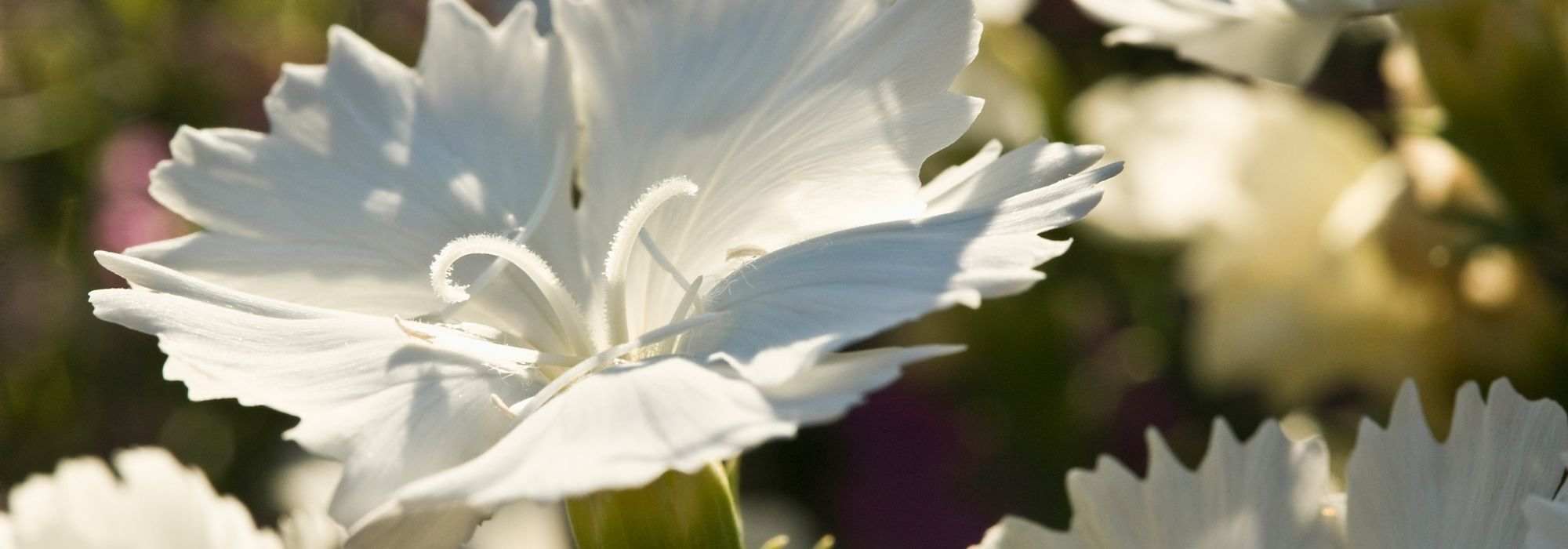

Dianthus plumarius Desmond
Dianthus plumarius Desmond
Dianthus plumarius Desmond
Common Pink, Garden Pink, Feathered Pink
Hello, I only knew old-fashioned pinks in pink and white, and here I discovered this red one. Finally, a red one! I exclaimed joyfully. And what a red! A vintage red, indeed blood red. Our era mostly favours scarlet and reds so dark they look black in the sun. Desmond is an old-fashioned pink that displays a red from the past. Some research allowed me to pinpoint its birth date around 1840. It's a pink that knew Balzac! But it's not just its age (because both old and modern have their wonders and their eyesores). Desmond is beautiful, with a simple beauty, unadorned. It's of its time and yet perfectly at ease in ours. Arriving last year, it took a little longer than the old Mrs Sinkins to establish itself, but it has nothing to envy her. Even the bluish foliage, like all the dainty ones that make neat little cushions all year round. Smart, cute, and fragrant, it's now approved for my small garden, which doesn't aspire to pose for magazines or play the exotic in farm country.
Philippe 87, 27/08/2024
Special offer!
Receive a €20 voucher for any order over €90 (excluding delivery costs, credit notes, and plastic-free options)!
1- Add your favorite plants to your cart.
2- Once you have reached €90, confirm your order (you can even choose the delivery date!).
3- As soon as your order is shipped, you will receive an email containing your voucher code, valid for 3 months (90 days).
Your voucher is unique and can only be used once, for any order with a minimum value of €20, excluding delivery costs.
Can be combined with other current offers, non-divisible and non-refundable.
Home or relay delivery (depending on size and destination)
Schedule delivery date,
and select date in basket
This plant carries a 12 months recovery warranty
More information
We guarantee the quality of our plants for a full growing cycle, and will replace at our expense any plant that fails to recover under normal climatic and planting conditions.

Would this plant suit my garden?
Set up your Plantfit profile →
Description
Dianthus plumarius 'Desmond', also known as Desmond carnation, is a very old variety. It is a timeless classic that is suitable for all uses. From summer to autumn, it produces dark red to blood-red double flowers, emitting a heady and spicy fragrance. Already popular with our great-grandmothers, this old variety combines sturdiness, an undemanding nature, and elegance. Ideal for rockeries, walls, and containers. Plant in full sun.
'Desmond' belongs to the Caryophyllaceae family. It is an old cultivar (before 1830) resulting from cross-breeding between D. plumarius and D. caryophyllus. D. plumarius is a European perennial and is the main ancestor of the different groups of carnations, both old-fashioned and modern. D. caryophyllus is Mediterranean, and it has passed on to its descendants its wonderful clove fragrance. This carnation's growth rate is quite rapid. Its adult size will not exceed 25 to 30cm (10 to 12in) in height with a spread of 30cm (12in). It forms a rather loose clump. From May to July, and again in September, it displays bouquets of intense dark red flowers, marked with purple at the centre, with numerous fringed petals. The highly fragrant flowers appear at the top of short stems and are usually single-flowered. The more it is pruned, the more it blooms. Its linear, glabrous, evergreen, and leathery leaves are a superb grey-blue-silver colour.
Dianthus plumarius 'Desmond' is a border plant, suitable for embankments and dry rockeries. It is also perfect for containers and bouquets. It can be paired with other flowering cushions such as rock roses, catchflies, dwarf wormwood (Artemisia lanata), wall bellflowers, Caucasian rockcress, creeping phlox, Delosperma cooperi, Erigeron karvinskianus, and bloody cranesbill (Geranium sanguineum). This plant looks beautiful between the stones of a wall or paving, or when planted en masse in a sunny garden. It adapts very well to pot cultivation, in light soil.
Dianthus plumarius Desmond in pictures




Flowering
Foliage
Plant habit
Botanical data
Dianthus
plumarius
Desmond
Caryophyllaceae
Common Pink, Garden Pink, Feathered Pink
Cultivar or hybrid
Other Dianthus - Pinks
View all →Planting and care
Plant Dianthus plumarius 'Desmond' in ordinary, permeable, humus-bearing, stony, preferably limestone, dry to moist, and especially well-drained soil. Gravel-rich soil yields good results. When planted in the ground, this plant shows a fair amount of hardiness, withstanding temperatures as low as -15°C (5°F). It prefers a very sunny exposure. Trim back the clump slightly after summer flowering to encourage a second blloming in September. In nutrient-rich soil, trim back some of the foliage with shears after flowering to maintain a dense habit. In poor soil, it will be beneficial to apply a balanced fertiliser in March. It is useful to divide the clumps every 3 years to rejuvenate those that are becoming bare at the base or to easily propagate through layering or cuttings.
Planting period
Intended location
Care
Planting & care advice
-
, onOrder confirmed
Reply from on Promesse de fleurs
Similar products
Haven't found what you were looking for?
Hardiness is the lowest winter temperature a plant can endure without suffering serious damage or even dying. However, hardiness is affected by location (a sheltered area, such as a patio), protection (winter cover) and soil type (hardiness is improved by well-drained soil).

Photo Sharing Terms & Conditions
In order to encourage gardeners to interact and share their experiences, Promesse de fleurs offers various media enabling content to be uploaded onto its Site - in particular via the ‘Photo sharing’ module.
The User agrees to refrain from:
- Posting any content that is illegal, prejudicial, insulting, racist, inciteful to hatred, revisionist, contrary to public decency, that infringes on privacy or on the privacy rights of third parties, in particular the publicity rights of persons and goods, intellectual property rights, or the right to privacy.
- Submitting content on behalf of a third party;
- Impersonate the identity of a third party and/or publish any personal information about a third party;
In general, the User undertakes to refrain from any unethical behaviour.
All Content (in particular text, comments, files, images, photos, videos, creative works, etc.), which may be subject to property or intellectual property rights, image or other private rights, shall remain the property of the User, subject to the limited rights granted by the terms of the licence granted by Promesse de fleurs as stated below. Users are at liberty to publish or not to publish such Content on the Site, notably via the ‘Photo Sharing’ facility, and accept that this Content shall be made public and freely accessible, notably on the Internet.
Users further acknowledge, undertake to have ,and guarantee that they hold all necessary rights and permissions to publish such material on the Site, in particular with regard to the legislation in force pertaining to any privacy, property, intellectual property, image, or contractual rights, or rights of any other nature. By publishing such Content on the Site, Users acknowledge accepting full liability as publishers of the Content within the meaning of the law, and grant Promesse de fleurs, free of charge, an inclusive, worldwide licence for the said Content for the entire duration of its publication, including all reproduction, representation, up/downloading, displaying, performing, transmission, and storage rights.
Users also grant permission for their name to be linked to the Content and accept that this link may not always be made available.
By engaging in posting material, Users consent to their Content becoming automatically accessible on the Internet, in particular on other sites and/or blogs and/or web pages of the Promesse de fleurs site, including in particular social pages and the Promesse de fleurs catalogue.
Users may secure the removal of entrusted content free of charge by issuing a simple request via our contact form.
The flowering period indicated on our website applies to countries and regions located in USDA zone 8 (France, the United Kingdom, Ireland, the Netherlands, etc.)
It will vary according to where you live:
- In zones 9 to 10 (Italy, Spain, Greece, etc.), flowering will occur about 2 to 4 weeks earlier.
- In zones 6 to 7 (Germany, Poland, Slovenia, and lower mountainous regions), flowering will be delayed by 2 to 3 weeks.
- In zone 5 (Central Europe, Scandinavia), blooming will be delayed by 3 to 5 weeks.
In temperate climates, pruning of spring-flowering shrubs (forsythia, spireas, etc.) should be done just after flowering.
Pruning of summer-flowering shrubs (Indian Lilac, Perovskia, etc.) can be done in winter or spring.
In cold regions as well as with frost-sensitive plants, avoid pruning too early when severe frosts may still occur.
The planting period indicated on our website applies to countries and regions located in USDA zone 8 (France, United Kingdom, Ireland, Netherlands).
It will vary according to where you live:
- In Mediterranean zones (Marseille, Madrid, Milan, etc.), autumn and winter are the best planting periods.
- In continental zones (Strasbourg, Munich, Vienna, etc.), delay planting by 2 to 3 weeks in spring and bring it forward by 2 to 4 weeks in autumn.
- In mountainous regions (the Alps, Pyrenees, Carpathians, etc.), it is best to plant in late spring (May-June) or late summer (August-September).
The harvesting period indicated on our website applies to countries and regions in USDA zone 8 (France, England, Ireland, the Netherlands).
In colder areas (Scandinavia, Poland, Austria...) fruit and vegetable harvests are likely to be delayed by 3-4 weeks.
In warmer areas (Italy, Spain, Greece, etc.), harvesting will probably take place earlier, depending on weather conditions.
The sowing periods indicated on our website apply to countries and regions within USDA Zone 8 (France, UK, Ireland, Netherlands).
In colder areas (Scandinavia, Poland, Austria...), delay any outdoor sowing by 3-4 weeks, or sow under glass.
In warmer climes (Italy, Spain, Greece, etc.), bring outdoor sowing forward by a few weeks.




























































